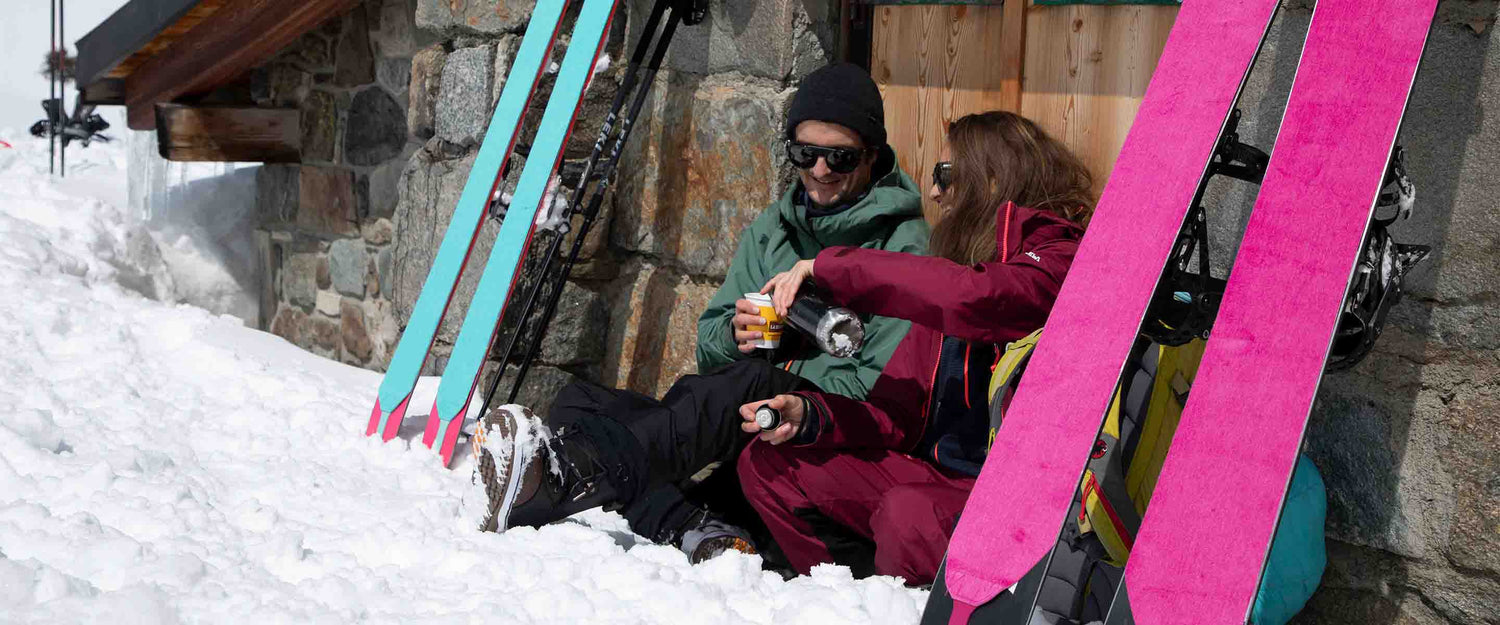Oberson x Pomoca
_____________________________
What Are Climbing Skins for?
Skins for ski touring have the mission of letting you explore uphill skin tracks with as much glide as grip, depending on the type of terrain. The skins have a glue side that sticks to the base of the equipment and a plush side that’s in contact with the snow. The length of the fibres varies, which has an impact on grip. Under normal conditions, longer hairs usually have more grip.
The fibres and their makeup determine the grip to glide ratio that allows you to smoothly travel on both flat sections (the fibres’ glide direction) and steep uphills (the fibres’ grip direction).
Precut Skins
Many brands offer precut skins for specific skis or boards (for specific sizes). They should fit the ski or splitboard perfectly without any need for cutting. If precut skis aren’t available for your model, or if you prefer skins in a different material, you’ll need to choose skins with the right length and width and cut them.
Skins for Alpine Touring Skis and Splitboards
It’s important to choose climbing skins designed for your type of equipment. There are skins for skis and splitboards. Their general composition is the same, but their width differs.

How to Choose the Size of Climbing Skins?
The different skin sizes are given in millimetres for width and centimetres for length. As far as measuring length is concerned, they are presented as a span between two measurements. For example, from 157 cm to 168 cm.

For Skis
How Wide Should Your Climbing Skins Be?
For optimal grip, choose skins that are about 5 to 6 millimetres narrower than the widest part of your ski, which is generally the tip. To determine this width, look at the three numbers in the sidecut (tip-waist-tail) and use the largest number. You can find them on the ski or the brand’s website. For example, for a ski with a 125-millimetre tip, go with 120-millimetre skins for good grip without covering the edges (which can be needed on steep terrain).
How Long Should Your Climbing Skins Be?
The skin’s length should be close to that of the ski. For example, for a 160 cm ski, choose skins between 157 cm and 168 cm. Since these models are generic, you will need to trim and adjust the skins to the skis, then add the tail attachments after you’ve cut the skins. However, some skins come with tail attachments that let you adjust the length within a certain range. In this case, follow the manufacturer’s recommendations to choose a length compatible with your skis.
For Splitboards
For splitboards, choosing the width is easy. There is only one size available, which is 145 mm. For length, the method is similar to that for skis. Splitboard skins come in small, medium, and large.
The idea is to always select a size that’s a little longer than that of the board. So if the splitboard is 154 cm, go with longer skins.

Climbing Skin Materials
Mohair Climbing Skins
Mohair is a natural material that provides excellent glide and lightness. Mohair skins are more compact and ideal for long outings where weight and space are issues in your touring backpack. They perform best on dry snow in cold temperatures.
Pros
- Lightweight
- Outstanding glide
- Compact
Cons
- Less durable
- Less grip
- Less effective on wet snow

Synthetic Climbing Skins
Synthetic climbing skins are made of nylon. They are more abrasion resistant and therefore more durable. Nylon is also more resistant to moisture and provides excellent grip for climbs. However, nylon skins are bulkier and have less glide.
Pros
- Abrasion resistance
- Durability
- Excellent grip
- Moisture resistance
Cons
- Bulkier
- Heavier
- Poorer glide
Hybrid Climbing Skins (Nylon and Mohair)
They’re the best compromise because they bring together all the advantages of the two materials. Hybrid skins are a blend of mohair and nylon that gives them good water resistance, weight and a reasonable volume. Another advantage is the grip-to-glide ratio.

Ski Width and Grip-Glide Ratio
It’s worth noting that ski width can also influence grip and glide, regardless of the skin material. Wider skins naturally provide slightly more grip because a larger surface area is in contact with the snow. But for the same reason, they also tend to glide less.
Moisture and Climbing Skins
Skins can sometimes get completely waterlogged. However, it’s not the plush that becomes wet, but the fabric—normally nylon or cotton—that joins it with the glue. To remedy the situation, Pomoca uses a waterproof membrane (incidentally the only brand of climbing skins to do so) that prevents the adhesive from getting wet. This membrane is also lighter and thinner than the fabric usually used. All Pomoca climbing skins are coated with a waterproofing treatment.

How to Cut Climbing Skins?
Several brands offer pre-cut skins for specific equipment. However, if you buy climbing skins that need to be cut, it’s critical to do it right. Most skins also come with a cutting tool. When cutting your skins, take your time to avoid mistakes that could affect how well they fit your skis. If you want optimal results without the risk for error, you can use the cutting service available in Oberson stores. Why not take advantage of it?
How to Put On Climbing Skins?
Before attaching climbing skins to your skis or splitboard, make sure the bases are clean and dry.
-
First attach the tip connector (aka tip hooks or tip bail) to the tip.
-
Press the initial portion of the skin onto the ski’s base from the tip to the waist, slightly pulling on it and making sure the ski’s edges are not covered.
-
Keep pressing the skin onto the base up to the tail.
-
Attach the tail clip to the tail.
-
Slide your hand over the length of the attached skin to make sure it is in contact with the base over its entire length.

How to Pack Skins during Transitions?
Once you’ve reached the top, remove your climbing skins from the bases of your skis or splitboard.
- Release the tail clip from the tail.
- Peel the climbing skin halfway off the base.
- Fold this first peeled part, glue on glue.
- Continue to peel the skin off up to the tip hooks.
- Fold this second part, glue on glue.
Once you’ve removed and folded both skins, you can store them in your coat so that they stay warm and the glue remains sticky when you put them back on. You can also put them in your touring backpack.
How to Store Climbing Skins?
After a wonderful day exploring, your skins will probably be wet or soaked. Always dry the skins before storing them. Also keep them away from woodstoves and fireplaces, and avoid leaving them in a warm car. Any heat source will affect the glue’s consistency, causing it to stick to the base of the ski or board on the next outing. At the end of the season, skins must be stored in their storage bag in a dry, cool place.

How to Take Care of Climbing Skins?
Get into the habit of waxing your skins with the appropriate products. You can also wax them during spring outings when snow can quickly accumulate on the skins and stop you from gliding. Over the years, glue inevitably deteriorates. However, you can change the adhesive layer. From their very first outings under your boards, always store your skins properly during transitions to avoid dirt and debris buildup.





